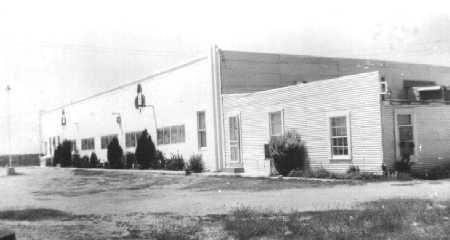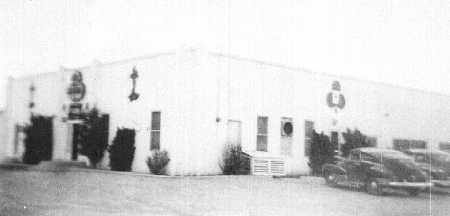
Rear view showing living quarters behind the Club; 1948. Enterprising owners would live on or near the business premises to take better care of the property. That is a good idea; even today.

With Air bases in Pyote, Marfa, & Midland the Air Force boys spent many happy hours dancing to a live band on a nice dance floor. Dancing to a good musical group being more enjoyable than a juke box.

Rear view showing living quarters behind the Club; 1948. Enterprising owners would live on or near the business premises to take better care of the property. That is a good idea; even today.
John Barleycorn
The model city of teetotalers was lost somewhere along the way.
E. F. and Tol Dawson were the first to buck the deed restriction against selling liquor on city lots. They reasoned that the limitation didn't apply to the streets, so they built a saloon in the street at 2nd and Lee. F. F. Dawson, the first sheriff, also had a barber chair in the back. The townsite officials took them to court and won.
J. R. and Charles Hilburn tested the clause again when they established another saloon on First Street at the corner of Grant. Ennis Lee and Tom McDougal were the barkeepers. They had a pool table and gambling tables in the back room and kept race horses stabled in the back.
John Thomas, another early sheriff, went into cahoots with Mollie Williams in the early 1900's and put in "Mollie & John's Saloon" on the corner of 2nd and Grant Street. They were a fun-loving pair full of mischief. This was a favorite hangout for cowboys and drifters. Their liquor-loosened tongues caused fist fights and fracases that sometimes resulted in gunfire.
There were frequent prohibition elections. The liquor advocates were almost outnumbered by the "drys" and had to "recruit" a few traveling people and derelicts from neighboring towns to help them carry the elections.
Odessa was making quite a name for itself as a place to "raise cain." It was the only "wet" spot in this part of the country, so many out-of-towners came and spent their money here. The town was wide open.
The liquor industry has rivaled livestock and oil. After the 1935 repeal of prohibition in Texas, Odessa was again the only "wet spot" in a radius of several hundred miles. This brought conventions, visitors, shoppers and meetings.
Bootlegging flourished as well, and liquor was hauled off to "dry" areas. This helped enhance Odessa's image as a rough and ready oil town.
From 1936 to the early 1950's there were more bars and package stores than all other retail outlets combined.
During the late 1930's and War years, the Loma Linda Club did a bang-up business, catering to the oilfield trade and the "flyboys" from the Midland Air Base at Terminal. They had a line of pretty "dime-a-dance" girls who encouraged the patrons to buy drinks. Others that were active included the Hillcrest, the Pullman Club, the Ace of Clubs and the Midway.
Night spots of the 1940's-early '50's which have slipped into history are: Danceland, LaFonda, The Oasis, Spanish Gardens, Playtime, The Silver Saddle, The Pelican, The Tumbleweed and The Roske.
Fist fights, cuss fights and hair pullings were commonplace. People crowded around to see who it was, then returned to their dancing. The bands played some fast, loud old favorite, the bouncer whopped them on the head with a blackjack if they got rough with him and tossed them outside for the law.
Colored neon lights flashed late into the night. Beer joints were side by side.
There were 335 establishments for the sale of alcoholic beverages at the last count and the number continues to grow. A typical Odessan, if one can be found, consumed 1.75 gallons of "hard" liquor, guzzled 29.7 gallons of beer and sipped .96 gallons of wine last year.
Courtesy: Hope Furlow.
Courtesy: Author; John Ben Shepperd & Wanda Snodgrass
Tim O'Reilly Illustrator.
Exchange Club Publication, July, 1981.
ODESSA 100; Read this book today!